Sometimes, unexpected, events lend themselves to a perfect teaching opportunity. This is the story of how I was able to teach real-life research to my students with two, tiny rescued kittens!
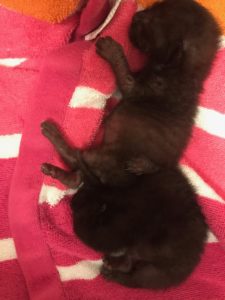
Nine weeks ago, someone abandoned two teeny tiny kittens in the parking lot of my school. They were crawling as best they could, lost and exposed on the pavement. The pair quickly found themselves inside a box in my library office.
Knowing I could not attend to them all day until my classes were done, I called my husband for help. After a quick trip to the veterinarian for emergency food, they were soon living in our bathroom. We named the lighter-haired boy Monkey, and we named the darker-haired girl Munchkin.
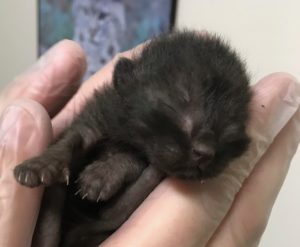
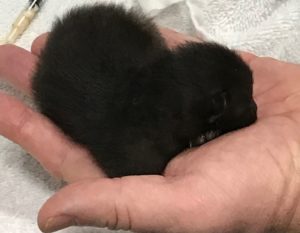
Their situation was pretty dire; according to our vet they were only four days old, far too young to be separated from their mother. Their eyes were still closed, along with their ears. She warned us they were not likely to survive, despite our best efforts to save them. Still, we had to try.
The vet instructed that we would need to keep them warm, bottle feed them every three hours, and try to provide some sort of feeling of safety and caring. Though my husband and I have both lived with cats since childhood, neither of us has raised kittens so young. We had so many questions, and felt so overwhelmed, that we looked everywhere for answers and help. We found books in my library, articles on reputable internet sites, and listened to countless friends, family, and even strangers who were willing to give us suggestions.
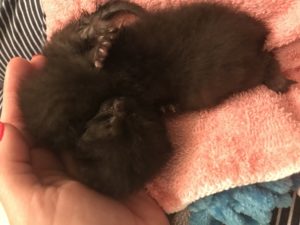
Students heard about the kittens and word spread that I had taken them home. Each day, they asked me tons of questions, so I decided to use this opportunity to demonstrate how research is a part of real-life. I showed them the books I had read, the resources I was using, and went over the information we had learned. I shared some of the obstacles Monkey and Munchkin had to overcome:
1. With no mother to feed them, they are entirely dependent on kitten formula and may not gain weight as quickly as other kittens. The formula had to be warmed up before giving it to them in the bottle.
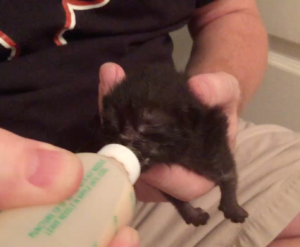
2. Without the antibodies a mother’s milk provides, their immune systems are not as strong as they should be. Plus, stray kittens are likely to have worms and other parasites.
3. Their temperature affects their appetites, and how well they digest what they eat. So we used a heating pad in their box to help keep them warm, but left room in the box where they could move off the heating pad if they got too hot.
4. They had to be stimulated to use the bathroom (this caused many giggles in all grade levels, as you would expect)
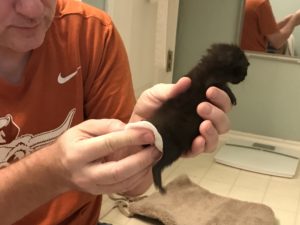
5. Most people know that kittens are born with their eyes closed, and don’t open them for 7-10 days. But kittens are born with their ears closed as well! At birth, they are both blind and deaf!
6. All kittens are born with blue eyes. Some will have blue eyes their entire lives. Others will change to a permanent color as they grow.
7. Some newborn kittens have very little fur on their feet! We think the feet in this picture look like something from a Harry Potter movie!!!

Everyone fell in love with the two babies, and always wanted a “Kitten Update” each time they visited the library. With each passing day, we could see them getting stronger and stronger. Unfortunately, things took a turn for the worse and Munchkin died after 10 days. It was particularly hard on us because she seemed to be doing well. When we first got them, she ate more than Monkey, and was the stronger of the two. But in a matter of hours, she suddenly stopped eating and grew weak. We rushed her to the veterinarian and even the ER, but the doctors said there wasn’t anything they could do to save her. The staff made a tiny memorial, saving her paw-prints in a piece of clay for us. When I told the students the next week, we cried together but I will never forget the absolute sweetness of one kindergarten boy who stood up, came and hugged me, and said “It’s okay Mrs. Liptak! You still have us!” xoxox
On the bright side, our sadness at losing Munchkin reinforced our desire to help Monkey. He continued to put on weight, the eye drops were clearing up his eye irritation, and the de-worming medicine seem to be working. After a traumatic beginning, he adapted pretty well to “life alone in the box”. Over the last 8 weeks, Monkey has gone from a frail 4.2 ounce kitty to a whopping 2 pounder whose energy is boundless!

As the school year was ending, and summertime was getting closer, my students were very concerned about Monkey and asked, “How are we going to know how Monkey is doing over the summer?” So, I told them that I would create a Monkey Google page, and post pictures and videos there throughout the summer so they can keep in touch. We invite you to check out Monkey’s page, and look forward to sharing Monkey’s story with you, your students, and your children too.










Resources for librarians, teachers, parents, & grandparents